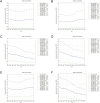Long-term trends and future projections of larynx cancer burden in China: a comprehensive analysis from 1990 to 2030 using GBD data
- PMID: 39489769
- PMCID: PMC11532332
- DOI: 10.1038/s41598-024-77797-6
Long-term trends and future projections of larynx cancer burden in China: a comprehensive analysis from 1990 to 2030 using GBD data
Abstract
Larynx cancer poses a significant public health challenge in China, with rising incidence and mortality rates over the past decades. Understanding the long-term trends and underlying factors is crucial for effective intervention and policy formulation. Data were utilized from the global burden of disease (GBD) Study 2021 to analyze the incidence, prevalence, mortality, disability-adjusted life years (DALYs), years lived with disability (YLDs), and years of life lost (YLLs) due to larynx cancer in China from 1990 to 2021. Joinpoint regression analysis identified key changes in trends, while age-period-cohort (APC) analysis and decomposition analysis quantified the contributions of aging, epidemiological changes, and population growth to these trends. Our study found a significant increase in the incidence and prevalence of larynx cancer in China, particularly among males. The age-standardized incidence rate (ASIR) and age-standardized mortality rate (ASMR) for males were substantially higher than those for females. Decomposition analysis revealed that aging was the primary driver of increasing incidence and mortality rates, while epidemiological changes had a mitigating effect. Joinpoint analysis identified periods of rapid urbanization and economic growth as key turning points for increased incidence. Bayesian APC models projected a continued upward trend in incidence rates up to 2030. The rising burden of larynx cancer in China underscores the need for targeted public health interventions, including smoking cessation programs, environmental pollution control, and early detection strategies. Addressing gender disparities and implementing effective prevention measures are crucial to mitigating the impact of larynx cancer in China.
Keywords: Aging; Bayesian age-period-cohort analysis; China; Disease burden; Epidemiological changes; Gender disparities; Incidence; Larynx cancer; Mortality; Prevalence.
© 2024. The Author(s).
Conflict of interest statement
The authors declare no competing interests.
Figures








References
-
- Bray, F. et al. Global cancer statistics 2022: GLOBOCAN estimates of incidence and mortality worldwide for 36 cancers in 185 countries. CA Cancer J. Clinicians 74 (3), 229–263 (2024). - PubMed
-
- Ramsey, T. et al. Laryngeal cancer: Global socioeconomic trends in disease burden and smoking habits. Laryngoscope 128 (9), 2039–2053 (2018). - PubMed
-
- Shen, Z., Li, J., Luo, L. & Han, L. The global, regional, and national burden of laryngeal cancer and the attributable risk factors in all countries and territories during 2007–2017. Front. Biosci. 26 (11), 1097–1105 (2021). - PubMed
-
- GBD 2017 Risk Factor Collaborators. Global, regional, and national comparative risk assessment of 84 behavioural, environmental and occupational, and metabolic risks or clusters of risks for 195 countries and territories, 1990–2017: a systematic analysis for the Global Burden of Disease Study 2017. Lancet (Lond. England) 392(10159), 1923–1994 (2018).10.1016/S0140-6736(18)32225-6 Erratum in: Lancet. 2019 Jan12;393(10167):132. 10.1016/S0140-6736(18)33216-1. Erratum in: Lancet. 2019 Jun 22;393(10190):e44. 10.1016/S0140-6736(19)31429-1. PMID: 30496105; PMCID: PMC6227755 - PMC - PubMed
MeSH terms
Grants and funding
- 2023Y9208/Grant from the Joint Funds for the innovation of science and Technology, Fujian province
- 2023J011271/Fujian Provincial Natural Science Foundation of China
- 2024J011077/Fujian Provincial Natural Science Foundation of China
- 2021QNA040/Fujian Provincial Health Technology Project
- 2022QH1153/Startup Fund for scientific research, Fujian Medical University
LinkOut - more resources
Full Text Sources
Miscellaneous

